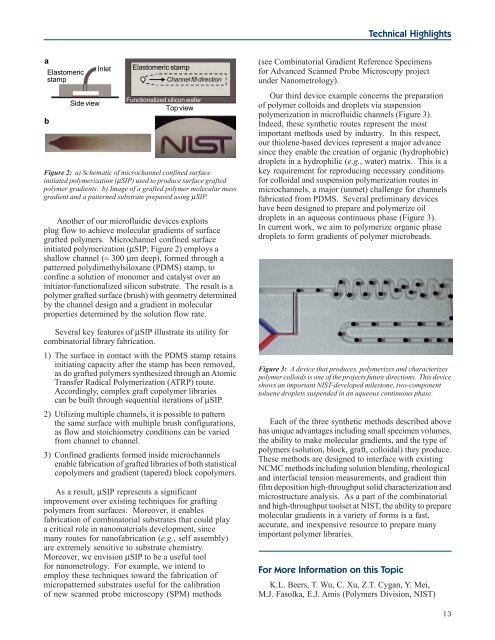Materials Science and Engineering Laboratory FY 2004 ... - NIST
Materials Science and Engineering Laboratory FY 2004 ... - NIST
Materials Science and Engineering Laboratory FY 2004 ... - NIST
Create successful ePaper yourself
Turn your PDF publications into a flip-book with our unique Google optimized e-Paper software.
Figure 2: a) Schematic of microchannel confined surface<br />
initiated polymerization (µSIP) used to produce surface grafted<br />
polymer gradients. b) Image of a grafted polymer molecular mass<br />
gradient <strong>and</strong> a patterned substrate prepared using µSIP.<br />
Another of our microfluidic devices exploits<br />
plug flow to achieve molecular gradients of surface<br />
grafted polymers. Microchannel confined surface<br />
initiated polymerization (µSIP; Figure 2) employs a<br />
shallow channel (≈ 300 µm deep), formed through a<br />
patterned polydimethylsiloxane (PDMS) stamp, to<br />
confine a solution of monomer <strong>and</strong> catalyst over an<br />
initiator-functionalized silicon substrate. The result is a<br />
polymer grafted surface (brush) with geometry determined<br />
by the channel design <strong>and</strong> a gradient in molecular<br />
properties determined by the solution flow rate.<br />
Several key features of µSIP illustrate its utility for<br />
combinatorial library fabrication.<br />
1) The surface in contact with the PDMS stamp retains<br />
initiating capacity after the stamp has been removed,<br />
as do grafted polymers synthesized through an Atomic<br />
Transfer Radical Polymerization (ATRP) route.<br />
Accordingly, complex graft copolymer libraries<br />
can be built through sequential iterations of µSIP.<br />
2) Utilizing multiple channels, it is possible to pattern<br />
the same surface with multiple brush configurations,<br />
as flow <strong>and</strong> stoichiometry conditions can be varied<br />
from channel to channel.<br />
3) Confined gradients formed inside microchannels<br />
enable fabrication of grafted libraries of both statistical<br />
copolymers <strong>and</strong> gradient (tapered) block copolymers.<br />
As a result, µSIP represents a significant<br />
improvement over existing techniques for grafting<br />
polymers from surfaces. Moreover, it enables<br />
fabrication of combinatorial substrates that could play<br />
a critical role in nanomaterials development, since<br />
many routes for nanofabrication (e.g., self assembly)<br />
are extremely sensitive to substrate chemistry.<br />
Moreover, we envision µSIP to be a useful tool<br />
for nanometrology. For example, we intend to<br />
employ these techniques toward the fabrication of<br />
micropatterned substrates useful for the calibration<br />
of new scanned probe microscopy (SPM) methods<br />
Technical Highlights<br />
(see Combinatorial Gradient Reference Specimens<br />
for Advanced Scanned Probe Microscopy project<br />
under Nanometrology).<br />
Our third device example concerns the preparation<br />
of polymer colloids <strong>and</strong> droplets via suspension<br />
polymerization in microfluidic channels (Figure 3).<br />
Indeed, these synthetic routes represent the most<br />
important methods used by industry. In this respect,<br />
our thiolene-based devices represent a major advance<br />
since they enable the creation of organic (hydrophobic)<br />
droplets in a hydrophilic (e.g., water) matrix. This is a<br />
key requirement for reproducing necessary conditions<br />
for colloidal <strong>and</strong> suspension polymerization routes in<br />
microchannels, a major (unmet) challenge for channels<br />
fabricated from PDMS. Several preliminary devices<br />
have been designed to prepare <strong>and</strong> polymerize oil<br />
droplets in an aqueous continuous phase (Figure 3).<br />
In current work, we aim to polymerize organic phase<br />
droplets to form gradients of polymer microbeads.<br />
Figure 3: A device that produces, polymerizes <strong>and</strong> characterizes<br />
polymer colloids is one of the projects future directions. This device<br />
shows an important <strong>NIST</strong>-developed milestone, two-component<br />
toluene droplets suspended in an aqueous continuous phase.<br />
Each of the three synthetic methods described above<br />
has unique advantages including small specimen volumes,<br />
the ability to make molecular gradients, <strong>and</strong> the type of<br />
polymers (solution, block, graft, colloidal) they produce.<br />
These methods are designed to interface with existing<br />
NCMC methods including solution blending, rheological<br />
<strong>and</strong> interfacial tension measurements, <strong>and</strong> gradient thin<br />
film deposition high-throughput solid characterization <strong>and</strong><br />
microstructure analysis. As a part of the combinatorial<br />
<strong>and</strong> high-throughput toolset at <strong>NIST</strong>, the ability to prepare<br />
molecular gradients in a variety of forms is a fast,<br />
accurate, <strong>and</strong> inexpensive resource to prepare many<br />
important polymer libraries.<br />
For More Information on this Topic<br />
K.L. Beers, T. Wu, C. Xu, Z.T. Cygan, Y. Mei,<br />
M.J. Fasolka, E.J. Amis (Polymers Division, <strong>NIST</strong>)<br />
13

















